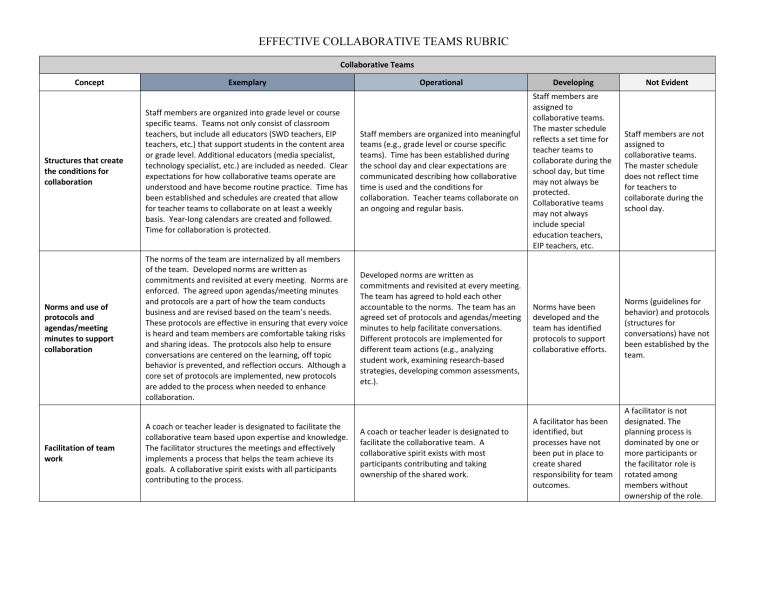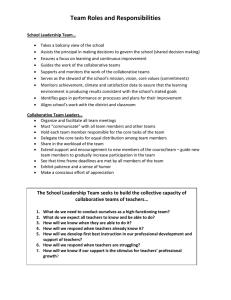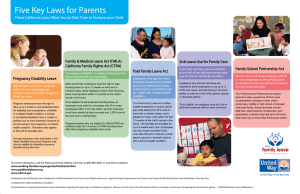
EFFECTIVE COLLABORATIVE TEAMS RUBRIC Collaborative Teams Concept Operational Developing Structures that create the conditions for collaboration Staff members are organized into grade level or course specific teams. Teams not only consist of classroom teachers, but include all educators (SWD teachers, EIP teachers, etc.) that support students in the content area or grade level. Additional educators (media specialist, technology specialist, etc.) are included as needed. Clear expectations for how collaborative teams operate are understood and have become routine practice. Time has been established and schedules are created that allow for teacher teams to collaborate on at least a weekly basis. Year-long calendars are created and followed. Time for collaboration is protected. Staff members are organized into meaningful teams (e.g., grade level or course specific teams). Time has been established during the school day and clear expectations are communicated describing how collaborative time is used and the conditions for collaboration. Teacher teams collaborate on an ongoing and regular basis. Staff members are assigned to collaborative teams. The master schedule reflects a set time for teacher teams to collaborate during the school day, but time may not always be protected. Collaborative teams may not always include special education teachers, EIP teachers, etc. Staff members are not assigned to collaborative teams. The master schedule does not reflect time for teachers to collaborate during the school day. Norms and use of protocols and agendas/meeting minutes to support collaboration The norms of the team are internalized by all members of the team. Developed norms are written as commitments and revisited at every meeting. Norms are enforced. The agreed upon agendas/meeting minutes and protocols are a part of how the team conducts business and are revised based on the team’s needs. These protocols are effective in ensuring that every voice is heard and team members are comfortable taking risks and sharing ideas. The protocols also help to ensure conversations are centered on the learning, off topic behavior is prevented, and reflection occurs. Although a core set of protocols are implemented, new protocols are added to the process when needed to enhance collaboration. Developed norms are written as commitments and revisited at every meeting. The team has agreed to hold each other accountable to the norms. The team has an agreed set of protocols and agendas/meeting minutes to help facilitate conversations. Different protocols are implemented for different team actions (e.g., analyzing student work, examining research-based strategies, developing common assessments, etc.). Norms have been developed and the team has identified protocols to support collaborative efforts. Norms (guidelines for behavior) and protocols (structures for conversations) have not been established by the team. A coach or teacher leader is designated to facilitate the collaborative team. A collaborative spirit exists with most participants contributing and taking ownership of the shared work. A facilitator has been identified, but processes have not been put in place to create shared responsibility for team outcomes. A facilitator is not designated. The planning process is dominated by one or more participants or the facilitator role is rotated among members without ownership of the role. Facilitation of team work Exemplary A coach or teacher leader is designated to facilitate the collaborative team based upon expertise and knowledge. The facilitator structures the meetings and effectively implements a process that helps the team achieve its goals. A collaborative spirit exists with all participants contributing to the process. Not Evident EFFECTIVE COLLABORATIVE TEAMS RUBRIC Collaborative Teams Concept Exemplary Operational Developing Not Evident Data analysis of student learning The team uses a combination of common diagnostic, summative, and formative assessments, as well as student work from performance tasks. Data are consistently analyzed to the standard/item level to identify indicators of student learning, strengths, weaknesses, and gaps in performance. Conversations occur that identify instructional strategies that have proven effective, either by teacher use or through research. These strategies are shared and modeled with team members. Effective remediation and enrichment strategies also result from the analysis of data. The team uses a combination of common diagnostic, summative, and formative assessments. Data are collected, charted, and analyzed to the standard/item level to identify indicators of student learning, strengths, weaknesses, and gaps in performance. The data reveals standards that are effectively taught as well as standards that may require additional teacher support. Instructional strategies are identified to improve instruction and address the needs of identified students. The team uses some diagnostic and some summative assessments and analyzes results. Data analysis is limited to the percent of students meeting and/or not meeting standards. A list of students or a report is generated. The team does not use interim data to inform instruction. No clear plans are made to evaluate the effectiveness of instruction. Data is limited to standardized assessments. Designs or revises curriculum documents and aligns resources Teachers use a common process to build or revise curriculum. Deliberate steps are taken for collaborative teams to reflect on the specific components of curriculum design (e.g., the standards, learning targets, tiered vocabulary, differentiated learning experiences, differentiated learning tasks, assessments, etc.). Implementation of a systematic and intentional process for developing or revising curriculum is understood and followed by all members of the team. Curriculum documents that are aligned with the intended rigor of the required standards are the products of this systematic, collaborative process. The curriculum documents are used and serve as a detailed roadmap that ensures students achieve the grade- or coursespecific standards. The collaborative team discusses the intent and rigor of the standards and reviews curriculum documents and resources to ensure alignment to the standards. A formal process is in place to design or revise curriculum that the team engages in on a regular basis. Systemic process for continuous improvement Team members have a clear understanding of the work of the collaborative team and understand that working together will have a positive impact on teaching and learning. Teachers implement a system to assess, plan, implement, and monitor for improvement of teaching and learning. The processes implemented build upon each other to create a cyclical system that the collaborative team implements over time. Processes engage the team in designing rigorous curriculum, units of study, common assessments, and effective instruction. The result includes clear expectations and a shared understanding of standards, curriculum, assessment, and instruction and leads to professional growth and increased student achievement. Teachers are aware of the connection between standards, curriculum, assessment, and instruction and have developed a process to assess, plan, implement, and monitor for improved teaching and learning. Team members consistently engage in collaborative teamwork which includes but is not limited to studying the intent and rigor of the standards, determining goals, developing common assessments and performance tasks, planning lessons and units, analyzing student work, using data to adjust instruction, incorporating research-based and high-impact strategies, etc. Curriculum documents and resources exist and are referenced or shared. A formal process is not consistently used to analyze or revise resources to ensure alignment to the intent and rigor of the standards. The collaborative team discusses standards, lessons, units, and assessments in isolation. The team has not established a systemic integrated process that connects planning, instruction, assessment, and reflection. A formal process to design, align, and revise curriculum documents (e.g., lesson plans, unit plans, performance, tasks, curriculum maps, scope and sequence documents, guides, etc.) does not exist. Team members are unsure of the work to be accomplished during the session. Collaborative time is consumed with grade level concerns, administrative and management tasks with little time focused on instructional practice.



